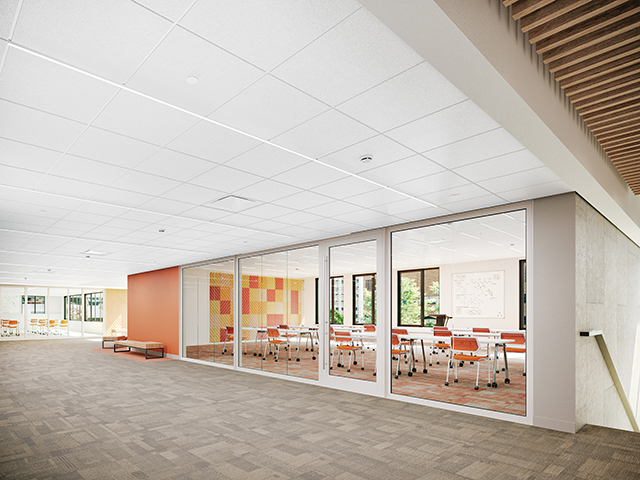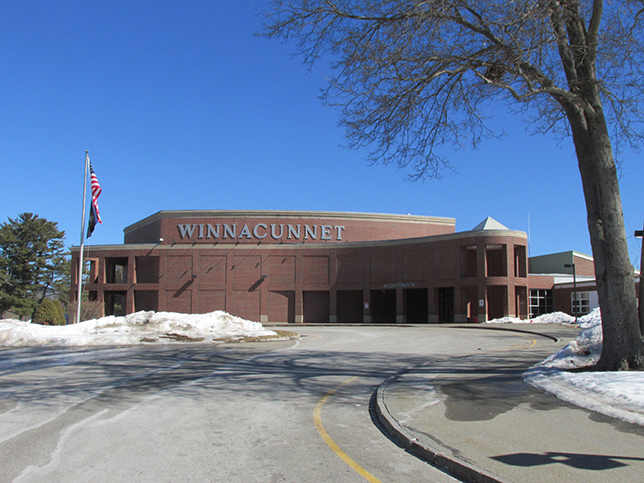Things are Looking Up for Energy Savings, Noise Reduction, and Better Student Performance
Ceiling innovations help overcome the challenges of budget, climate change, and aging systems
By Michael Dunn and Jason Cavanaugh
Schools nationwide—especially those in historically cool climates now undergoing elevated heat events—face a challenging cycle when it comes to adapting to climate-change-driven temperature extremes during the school year. Often if heating, ventilation, and air conditioning (HVAC) systems even exist, they are nearing end of life and operating less efficiently. Facing limited budgets, schools often opt for repairs over equipment replacement even though repairs can be costly and newer systems are designed for more efficient, sustainable operation offering long-term energy and cost savings.
According to a report by the U.S. Government Accountability Office, approximately 36,000 schools need to update or replace their HVAC systems—and many operate with no air conditioning at all. Energy Star reports K-12 school districts nationwide annually spend more than $8 billion on energy costs. Lastly, a study from Harvard University analyzing high schools in New York state indicated that exam performance drops on a 90-degree day compared to a 72-degree day. These examples emphasize that schools are in dire need of solutions to their comfort woes.
Recent innovations using Phase Change Material (PCM)—a well-known technology—in ceiling panels offer solutions to many of these challenges. PCM ceilings offer a natural way to reduce peak temperatures or increase low ones in a space through the absorption and storage of heat during high-temperature load periods, and the release of heat as the space cools down. PCM ceilings regulate temperature without an energy source, such as electricity, and don’t require maintenance associated with mechanical equipment.
In terms of effectiveness, we can look at mineral fiber ceiling panels with PCM, for example. Mineral fiber ceiling panels that utilize PCM technology can reduce energy costs and consumption by up to 15 percent (according to recent research estimates measured in lab tests). These benefits, recognized in thermally massive buildings, are now accessible for any building with a simple ceiling panel replacement. In addition, these panels include total acoustics performance, which enhances Indoor Environmental Quality (IEQ) by providing both sound-blocking and sound-absorption.

Images courtesy of Armstrong World Industries
PCM Technology 101
The PCM in ceiling panels works similarly to ice in a cooler. Ceiling panel PCM changes phase around a comfortable indoor air temperature of 72 degrees. As a space warms—typically during the day when it is occupied or receives sunlight—the crystalized PCM gradually dissolves, absorbing heat and cooling the space. As the room cools at night or during low-occupancy times, the stored heat is released into the space and the PCM re-crystalizes. In this way, heat transfers naturally into and out of the ceiling panels at 72 degrees, allowing it to be effective for both cooling and heating. To optimize PCM technology, we recommend 50% to 75% coverage of a given space with the PCM ceiling panels.
It’s important to reiterate that PCM works passively by harnessing the natural temperature variation of a space over a 24-hour day. PCM’s ability to moderate temperatures and reduce “peaks” can result in HVAC systems running less frequently.
Energy Savings—Just the Beginning
Our team is engaged in an ongoing case study with Winnacunnet High School. Located in New Hampshire, the school faced high overnight heating costs to keep classrooms warm for the start of the next school day. Data was obtained over several months for four classrooms with a constant daytime-nighttime heat setpoint. Two classrooms were retrofitted with our PCM energy saving ceiling panels and two were not. Results showed the rooms with the PCM ceilings have experienced 5% to 9% reduction in nighttime heating energy.

As this case study demonstrates, lower energy consumption and consequential cost savings is an important motivator for using PCM ceiling panels. However, PCM ceilings also offer schools a host of other benefits. Moreover, since every school needs ceiling panels, the PCM option leverages existing assets through retrofit or new-ceiling investment to improve environmental comfort and energy savings with minimal incremental cost. Key benefits include:
- Economical alternative—when budget does not allow for HVAC system retrofits or replacement and/or for buildings in climates requiring air conditioning for fewer than 20 days during the school year
- Maintaining comfort in changing climates or environments with daily hot-cold fluctuations without additional energy costs
- Reduced carbon footprint plus lower energy expenditure and wear-and-tear on equipment
- Helps mitigate challenges—including budgetary and increased strain on HVAC infrastructure—of building electrification
- Temperature stabilization and prevention of overheating/overcooling inefficiencies in spaces with intermittent daily heat/cold loads
- Blending with acoustical sound-absorption and sound-blocking ceiling panel technology
- Non-labor intensive, relatively fast installation; can likely be done by your maintenance staff
- Fits into the thermal comfort portion of the WELL Building Standard™ and can contribute to energy and atmosphere credits for LEED®
- Ability to create optimal pre-cooling or pre-heating strategies to reduce the burden on HVAC systems during peak hours
Points to Consider
When outlining your school’s PCM ceiling strategy, it’s important to consider your climate as well as the particulars of your building. PCM ceilings are ideal for climates with large day-to-night temperature swings, such as hot Southwestern or cold New England coastal regions. In addition, they can benefit buildings in regions with high energy costs or peak demand charges.
Next, look at your building’s individual spaces to identify where to start. In general, because schools have high occupancy—and, therefore, higher internal heat loads—during the day, many areas, such as classrooms and gymnasiums, can experience advantages with a PCM ceiling. The same holds true for rooms with extensive sun exposure; large open spaces with high ceilings, such as atriums; rooms on the top floor; and wings/annexes with multiple exterior walls making them more susceptible to outside air temperature fluctuations.
Lastly, while it’s recommended PCM ceiling panels be used for an entire room, it’s not necessary to do an entire building at once. To accommodate budgets, start with rooms that have had challenges with being too hot, too cold, or unpredictable, or areas utilizing older, less efficient HVAC systems.
Conclusion
For decades, PCM technology has been used and proven in multiple applications. Its recent integration into ceiling panels makes this technology and all its indoor temperature stabilization benefits more accessible than ever through an easy ceiling retrofit. Early adopters are already experiencing the impact PCM ceilings can have on reducing energy expenditure and heating and cooling needs. They also benefit from the ways more efficient HVAC operation can create sustainable and resilient spaces and support entire buildings in being more energy stable. As your school strategizes for better energy management, bringing PCM ceilings into the mix can support sustainability goals, budgetary needs, the well-being of your students and staff, and better educational outcomes.
Michael Dunn is the Technical Sales Manager for Energy Savings and Phase Change Materials, and Jason Cavanaugh a Mechanical Engineer, both with Armstrong World Industries.